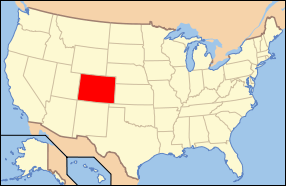Colorado wine
| Wine region | |
 | |
| Official name | State of Colorado |
|---|---|
| Type | U.S. state |
| Year established | 1876 |
| Country | United States |
| Sub-regions | Grand Valley AVA, West Elks AVA |
| Total area | 104,185 square miles (269,838 km2) |
| Size of planted vineyards | 1,000 acres (405 ha)[1] |
| Grapes produced | Cabernet Franc, Cabernet Sauvignon, Chambourcin, Chardonel, Chardonnay, Cinsault, Gewurztraminer, Lemberger, Marechal Foch, Merlot, Muscat Canelli, Orange Muscat, Petit Verdot, Pinot gris, Pinot noir, Riesling, Sangiovese, Sauvignon blanc, Semillon, Seyval blanc, Syrah, Viognier, Zinfandel[1] |
| No. of wineries | approx 100 |
Colorado wine refers to wine made from grapes grown in the U.S. state of Colorado. Most of Colorado's vineyards are located on the western slope of the Rocky Mountains, though an increasing number of wineries are located along the Front Range.
Geography and climate
Colorado's grape growing regions contain some of the highest elevation vineyards in the world, with most viticulture in the state practiced between 4,000 feet (1,219 m) and 7,000 feet (2,134 m) feet above sea level. The mountain climate ensures warm summer days and cool nights. Colorado is home to two designated American Viticultural Areas of the Grand Valley AVA and the West Elks AVA, where most of the vineyards in the state are located. Approximately 100 commercial wineries operate in Colorado and about 1,000 acres (405 ha) are planted to grapevines.[1] Other wine regions include: the Four Corners area near Cortez, near Canyons of the Ancients National Monument, and Durango; Pikes Peak/Arkansas River Valley near Salida, Canon City, and Manitou Springs; and the Front Range between Fort Collins and Castle Rock, with many wineries located in the Denver metropolitan area.
History
Grapevines were first brought to Colorado in the 19th century by miners in southern Colorado. The first agricultural record of vineyards was when Governor George A. Crawford, founder of Grand Junction planted 60 acres of grapes and other fruit near Palisade. Like in other areas Prohibition in the United States virtually wiped out the Colorado wine industry in the early twentieth century only to have it resurrected again in the 1960s. In 1968, Gerald Ivancie opened Ivancie Winery in Denver using grapes from California, but was instrumental in developing experimental plantings of premium wine grapes in and around the Grand Valley.[2] Ivancie's winemaker was Warren Winiarski, who was the first winemaker at Robert Mondavi Winery and rose to fame when he won the Judgement of Paris (wine) tasting in 1976 for his Stag's Leap Wine Cellars S.L.V Cabernet Sauvignon.[3][4]
In 1990, with five operating wineries, the Colorado General Assembly created the Colorado Wine Industry Development Board.[5] In 2010, there are now approximately 115 commercial wineries in Colorado.
Grapes
The most popular grapes grown in Colorado are varieties in the species of European grape Vitis vinifera. The most popular red varieties are Merlot, Cabernet Sauvignon, Syrah, and Cabernet Franc. The most popular white varieties are Chardonnay, Riesling, and Viognier.[6]
See also
References
- 1 2 3 Appellation America (2007). "Colorado: Appellation Description". Retrieved Nov. 27, 2007.
- ↑ http://www.coloradowine.com
- ↑ http://www.denverpost.com/food/ci_25883924/arrival-our-wines
- ↑ http://www.coloradowinepress.com/2014/05/the-first-flying-winemaker.html
- ↑ http://www.coloradowine.com/pdf/WineDevelAct.pdf
- ↑ http://www.coloradowine.com/pdf/AWS%207%20Nov%2008.pdf